diagram SUZUKI SWIFT 2000 1.G RG413 Service User Guide
[x] Cancel search | Manufacturer: SUZUKI, Model Year: 2000, Model line: SWIFT, Model: SUZUKI SWIFT 2000 1.GPages: 698, PDF Size: 16.01 MB
Page 416 of 698
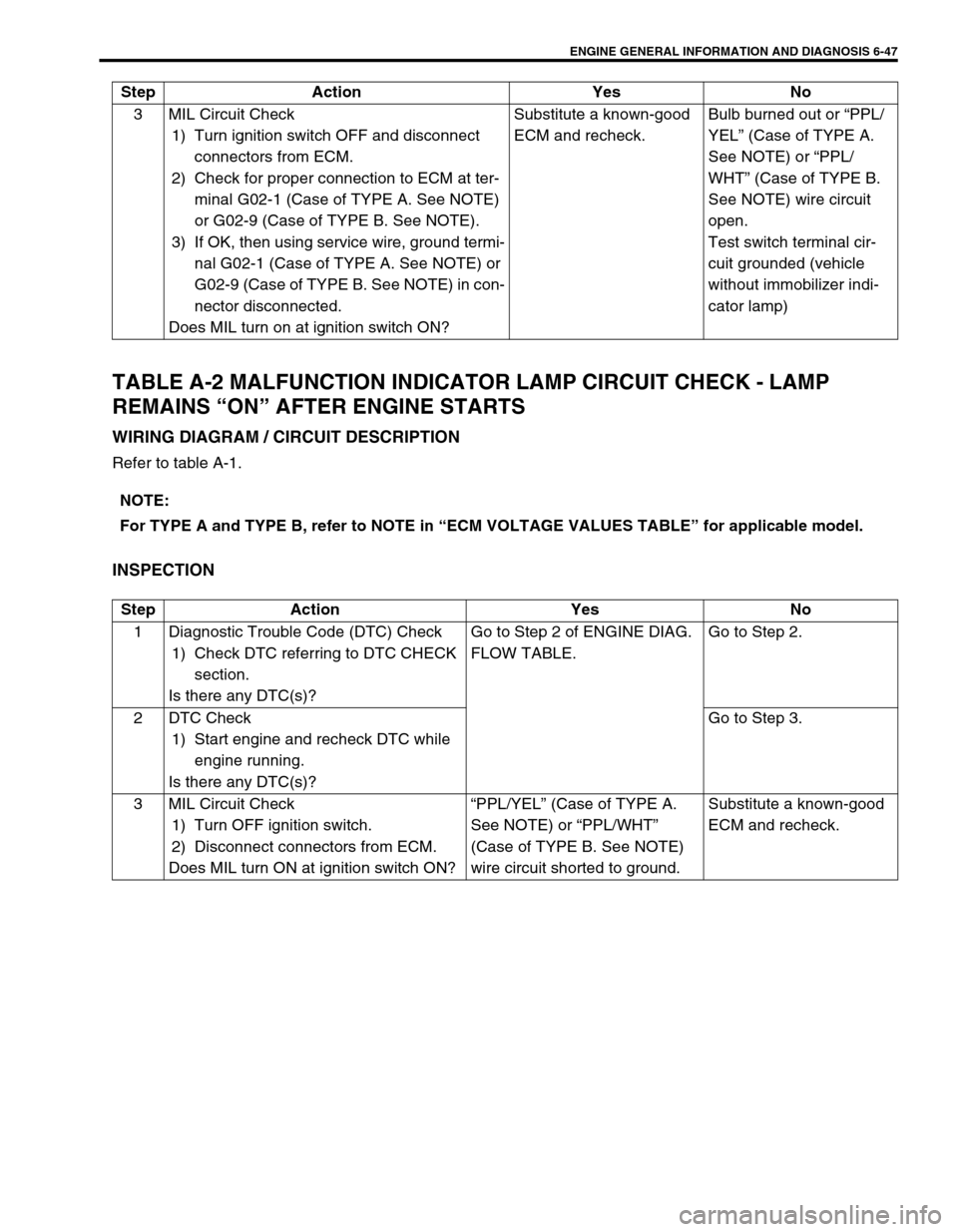
ENGINE GENERAL INFORMATION AND DIAGNOSIS 6-47
TABLE A-2 MALFUNCTION INDICATOR LAMP CIRCUIT CHECK - LAMP
REMAINS “ON” AFTER ENGINE STARTS
WIRING DIAGRAM / CIRCUIT DESCRIPTION
Refer to table A-1.
INSPECTION
3 MIL Circuit Check
1) Turn ignition switch OFF and disconnect
connectors from ECM.
2) Check for proper connection to ECM at ter-
minal G02-1 (Case of TYPE A. See NOTE)
or G02-9 (Case of TYPE B. See NOTE).
3) If OK, then using service wire, ground termi-
nal G02-1 (Case of TYPE A. See NOTE) or
G02-9 (Case of TYPE B. See NOTE) in con-
nector disconnected.
Does MIL turn on at ignition switch ON?Substitute a known-good
ECM and recheck.Bulb burned out or “PPL/
YEL” (Case of TYPE A.
See NOTE) or “PPL/
WHT” (Case of TYPE B.
See NOTE) wire circuit
open.
Test switch terminal cir-
cuit grounded (vehicle
without immobilizer indi-
cator lamp) Step Action Yes No
NOTE:
For TYPE A and TYPE B, refer to NOTE in “ECM VOLTAGE VALUES TABLE” for applicable model.
Step Action Yes No
1 Diagnostic Trouble Code (DTC) Check
1) Check DTC referring to DTC CHECK
section.
Is there any DTC(s)?Go to Step 2 of ENGINE DIAG.
FLOW TABLE.Go to Step 2.
2DTC Check
1) Start engine and recheck DTC while
engine running.
Is there any DTC(s)?Go to Step 3.
3 MIL Circuit Check
1) Turn OFF ignition switch.
2) Disconnect connectors from ECM.
Does MIL turn ON at ignition switch ON?“PPL/YEL” (Case of TYPE A.
See NOTE) or “PPL/WHT”
(Case of TYPE B. See NOTE)
wire circuit shorted to ground.Substitute a known-good
ECM and recheck.
Page 417 of 698

6-48 ENGINE GENERAL INFORMATION AND DIAGNOSIS
TABLE A-3 MIL CHECK - MIL FLASHES AT IGNITION SWITCH ON (VEHICLE
WITHOUT IMMOBILIZER INDICATOR LAMP)
WIRING DIAGRAM / CIRCUIT DESCRIPTION
Refer to TABLE A-1.
INSPECTION
TABLE A-4 MIL CHECK - MIL DOES NOT FLASH OR JUST REMAINS ON EVEN
WITH GROUNDING DIAGNOSIS SWITCH TERMINAL (VEHICLE WITHOUT
IMMOBILIZER INDICATOR LAMP)
WIRING DIAGRAM / CIRCUIT DESCRIPTION
Refer to TABLE A-1.
INSPECTION
NOTE:
For TYPE A and TYPE B, refer to NOTE in “ECM VOLTAGE VALUES TABLE” for applicable model.
Step Action Yes No
1 MIL Flashing Pattern Check
1) Turn ignition switch ON.
Does lamp flashing pattern indicate diag-
nostic trouble code?Go to Step 2. Substitute a known-good ECM
and recheck.
2 Diag. Switch Circuit Check
Is diag. switch terminal connected to
ground via service wire?System is in good condi-
tion.“PPL/WHT” circuit for monitor
connector shorted to ground. If
circuit is OK substitute a known-
good ECM and recheck.
NOTE:
For TYPE A and TYPE B, refer to NOTE in “ECM VOLTAGE VALUES TABLE” for applicable model.
Step Action Yes No
1 MIL Circuit Check
1) Turn ignition switch OFF and disconnect connec-
tors from ECM.
Does MIL turn ON at ignition switch ON?“PPL/YEL” (Case of TYPE A.
See NOTE) or “PPL/WHT”
(Case of TYPE B. See NOTE)
circuit shorted to ground.Go to Step 2.
2 ECM/PCM Connection Check
1) Turn ignition switch OFF.
Is connector (C42-27 (Case of TYPE A. See NOTE)
or C41-14 (Case of TYPE B. See NOTE) connection)
connected to ECM/PCM properly?Go to Step 3. Poor connector connec-
tion.
3 Diag. Switch Terminal Circuit Check
1) Connect connectors to ECM.
2) Using service wire, ground C42-27 (Case of
TYPE A. See NOTE) or C41-14 (Case of TYPE
B. See NOTE) connection) terminal with connec-
tors connected to ECM.
3) Turn ignition switch ON.
Does MIL flash?“PPL/WHT” or “BLK” circuit in
monitor connector is open.Substitute a known-good
ECM and recheck.
Page 418 of 698

ENGINE GENERAL INFORMATION AND DIAGNOSIS 6-49
TABLE A-5 ECM POWER AND GROUND CIRCUIT CHECK - MIL DOESN’T
LIGHT AT IGNITION SWITCH ON AND ENGINE DOESN’T START THOUGH IT IS
CRANKED UP
WIRING DIAGRAM
CIRCUIT DESCRIPTION
When the ignition switch tuned ON, the main relay turns ON (the contact point closes) and the main power is
supplied to ECM.
1. BATT fuse 3. IG METER fuse 5. Monitor connector
2. Main fuse box 4. To battery 6. MIL (if equipped)
[A] : Case of TYPE A is shown (See NOTE) [B] : Case of TYPE B is shown (See NOTE)
1
12V5V
ECM
23
+BB
DA
C
BLK/WHT
BRN/WHT
BLK/RED
BLK/RED
C42 (31P) C41 (24P) G02 (17P)1 2 3 4 5 6 7 8 9
10 11 12 13 14 15 16 17 18 19 20 21
22 23 24 25 26 28 27 29 30 315 6
1 2 3 4 5 6 7
11 12
9 10 11 13 12 14 15 16
16 171 2
7 8
13 14 3 4
9 10
15 17 188
19 20 21 22 23 24
BLK
DN
TS
GNDMON
PPL/WHTC42-27 [A]
C42-16 [A]
PNK/BLUC42-28 [A]
7 4
G02-1 [A]IG1PPL/YEL [A]
5
6IG1
WHT/GRN
BLK/WHT
G02-6 [A]
C41-5 C41-6 C41-10 C41-11 [B]C41-14 [B]
C41-15 [B]
C41-8 [B]
G02-9 [B]PPL/WHT [B]
NOTE:
For TYPE A and TYPE B, refer to NOTE in “ECM VOLTAGE VALUES TABLE” for applicable model.
Page 421 of 698
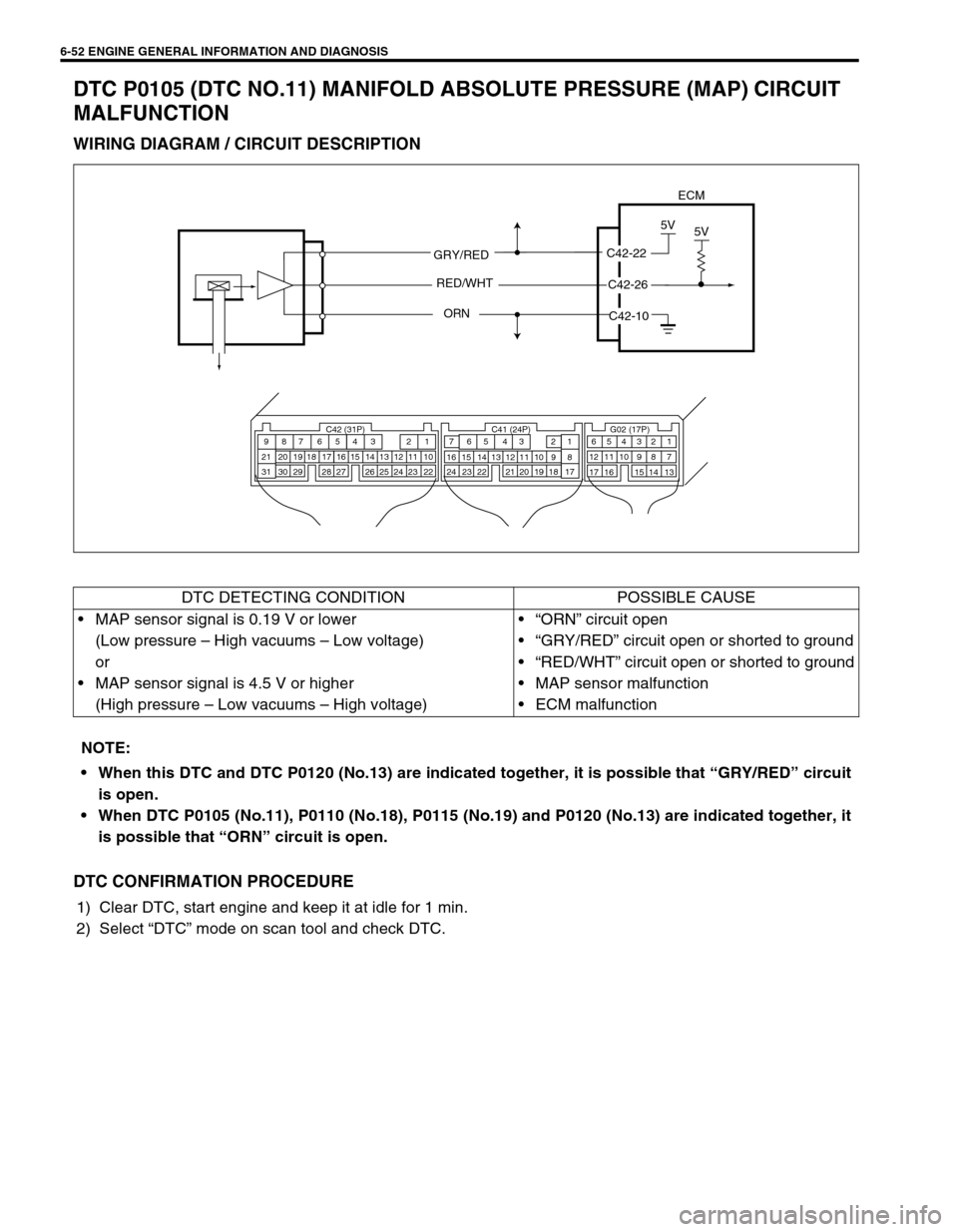
6-52 ENGINE GENERAL INFORMATION AND DIAGNOSIS
DTC P0105 (DTC NO.11) MANIFOLD ABSOLUTE PRESSURE (MAP) CIRCUIT
MALFUNCTION
WIRING DIAGRAM / CIRCUIT DESCRIPTION
DTC CONFIRMATION PROCEDURE
1) Clear DTC, start engine and keep it at idle for 1 min.
2) Select “DTC” mode on scan tool and check DTC.
ECM
GRY/RED
ORN
C42-22
5V
AMPC42-26
5V
RED/WHT
C42-10
C42 (31P) C41 (24P) G02 (17P)1 2 3 4 5 6 7 8 9
10 11 12 13 14 15 16 17 18 19 20 21
22 23 24 25 26 28 27 29 30 315 6
1 2 3 4 5 6 7
11 12
9 10 11 13 12 14 15 16
16 171 2
7 8
13 14 3 4
9 10
15 17 188
19 20 21 22 23 24
DTC DETECTING CONDITION POSSIBLE CAUSE
MAP sensor signal is 0.19 V or lower
(Low pressure – High vacuums – Low voltage)
or
MAP sensor signal is 4.5 V or higher
(High pressure – Low vacuums – High voltage)“ORN” circuit open
“GRY/RED” circuit open or shorted to ground
“RED/WHT” circuit open or shorted to ground
MAP sensor malfunction
ECM malfunction
NOTE:
When this DTC and DTC P0120 (No.13) are indicated together, it is possible that “GRY/RED” circuit
is open.
When DTC P0105 (No.11), P0110 (No.18), P0115 (No.19) and P0120 (No.13) are indicated together, it
is possible that “ORN” circuit is open.
Page 424 of 698
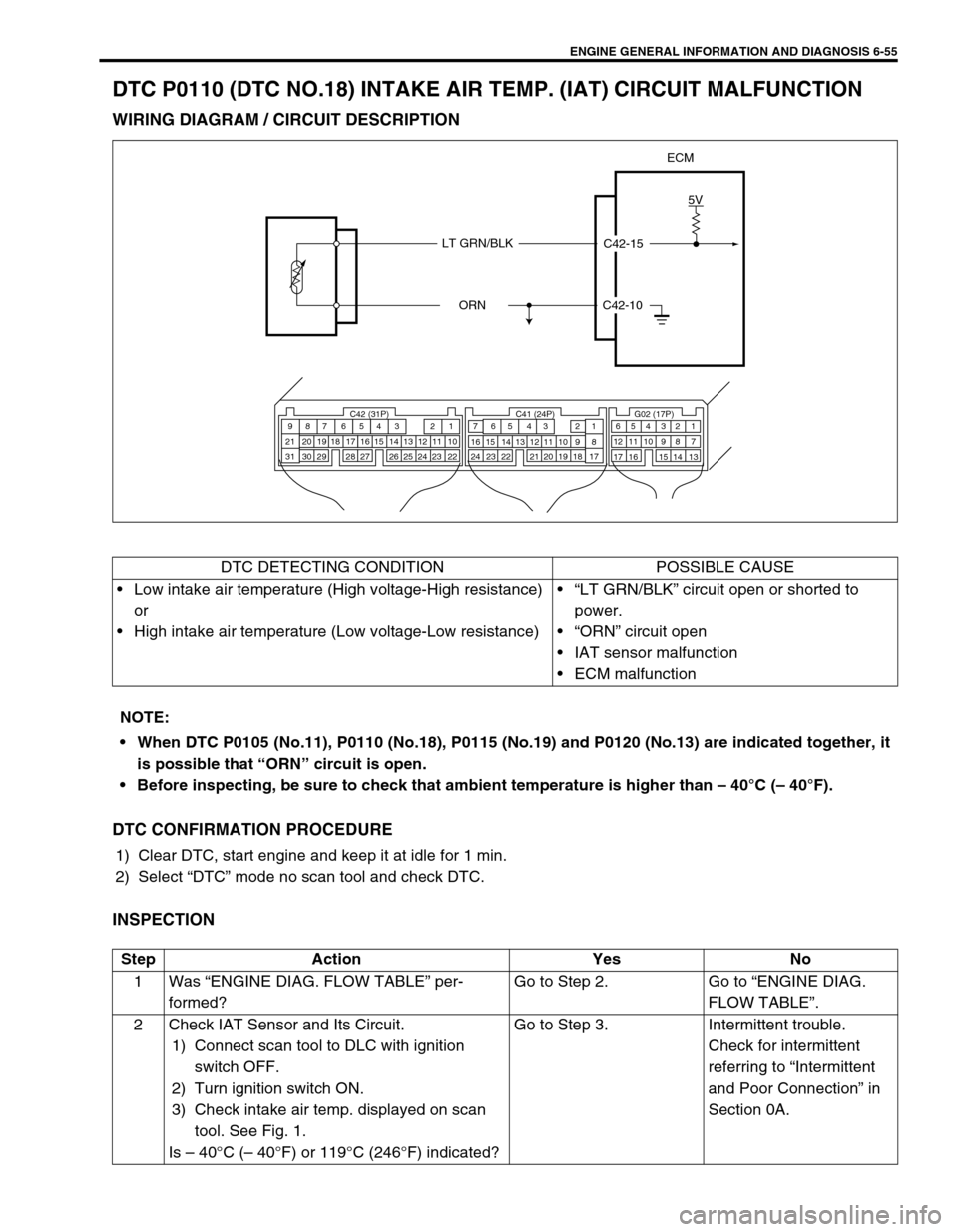
ENGINE GENERAL INFORMATION AND DIAGNOSIS 6-55
DTC P0110 (DTC NO.18) INTAKE AIR TEMP. (IAT) CIRCUIT MALFUNCTION
WIRING DIAGRAM / CIRCUIT DESCRIPTION
DTC CONFIRMATION PROCEDURE
1) Clear DTC, start engine and keep it at idle for 1 min.
2) Select “DTC” mode no scan tool and check DTC.
INSPECTION
C42-10
C42-15
5V
ECM
LT GRN/BLK
ORN
C42 (31P) C41 (24P) G02 (17P)1 2 3 4 5 6 7 8 9
10 11 12 13 14 15 16 17 18 19 20 21
22 23 24 25 26 28 27 29 30 315 6
1 2 3 4 5 6 7
11 12
9 10 11 13 12 14 15 16
16 171 2
7 8
13 14 3 4
9 10
15 17 188
19 20 21 22 23 24
DTC DETECTING CONDITION POSSIBLE CAUSE
Low intake air temperature (High voltage-High resistance)
or
High intake air temperature (Low voltage-Low resistance)“LT GRN/BLK” circuit open or shorted to
power.
“ORN” circuit open
IAT sensor malfunction
ECM malfunction
NOTE:
When DTC P0105 (No.11), P0110 (No.18), P0115 (No.19) and P0120 (No.13) are indicated together, it
is possible that “ORN” circuit is open.
Before inspecting, be sure to check that ambient temperature is higher than – 40°C (– 40°F).
Step Action Yes No
1Was “ENGINE DIAG. FLOW TABLE” per-
formed?Go to Step 2. Go to “ENGINE DIAG.
FLOW TABLE”.
2 Check IAT Sensor and Its Circuit.
1) Connect scan tool to DLC with ignition
switch OFF.
2) Turn ignition switch ON.
3) Check intake air temp. displayed on scan
tool. See Fig. 1.
Is – 40°C (– 40°F) or 119°C (246°F) indicated?Go to Step 3. Intermittent trouble.
Check for intermittent
referring to “Intermittent
and Poor Connection” in
Section 0A.
Page 426 of 698
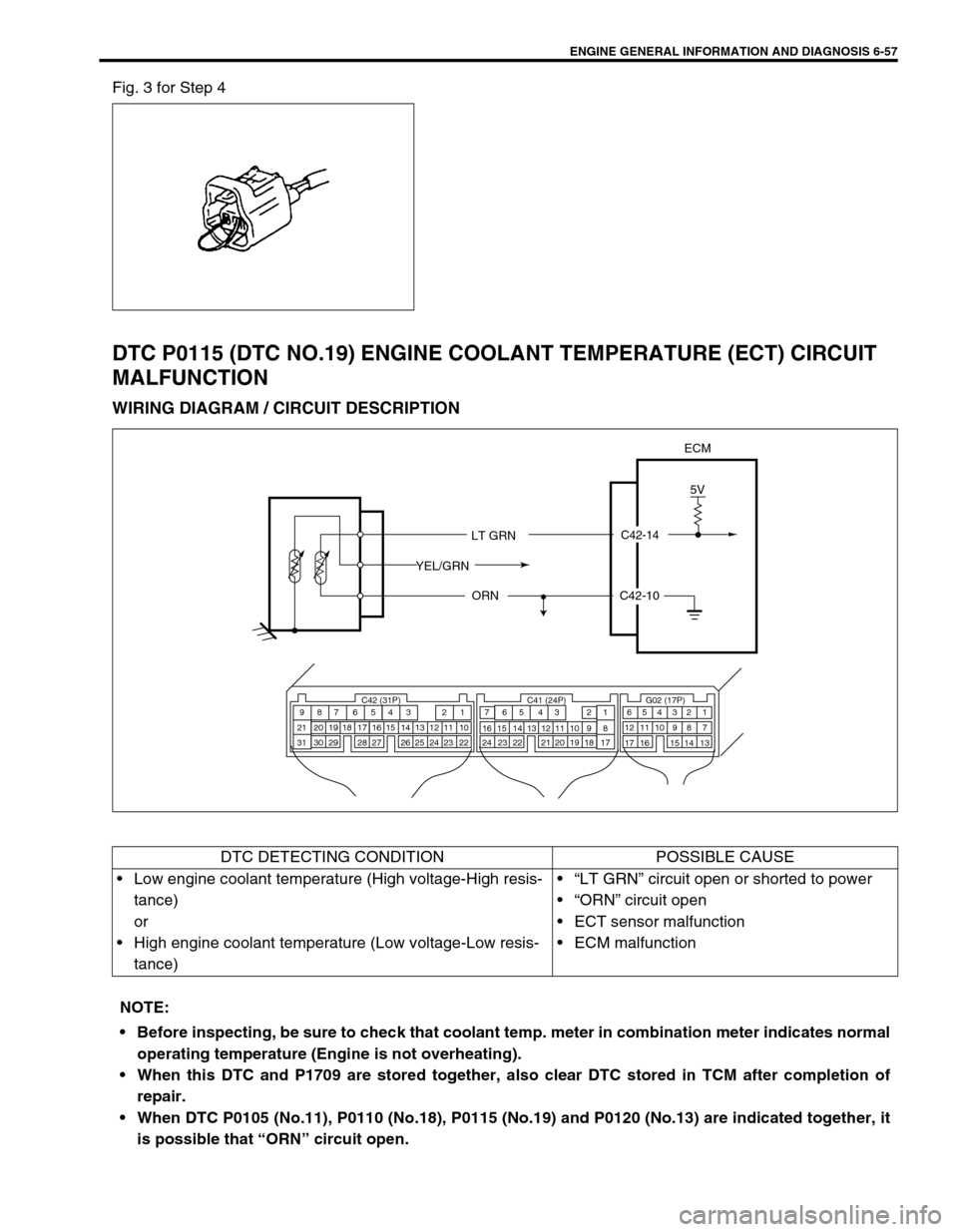
ENGINE GENERAL INFORMATION AND DIAGNOSIS 6-57
Fig. 3 for Step 4
DTC P0115 (DTC NO.19) ENGINE COOLANT TEMPERATURE (ECT) CIRCUIT
MALFUNCTION
WIRING DIAGRAM / CIRCUIT DESCRIPTION
C42-14
5V
ECM
LT GRN
ORN
YEL/GRN
C42-10
C42 (31P) C41 (24P) G02 (17P)1 2 3 4 5 6 7 8 9
10 11 12 13 14 15 16 17 18 19 20 21
22 23 24 25 26 28 27 29 30 315 6
1 2 3 4 5 6 7
11 12
9 10 11 13 12 14 15 16
16 171 2
7 8
13 14 3 4
9 10
15 17 188
19 20 21 22 23 24
DTC DETECTING CONDITION POSSIBLE CAUSE
Low engine coolant temperature (High voltage-High resis-
tance)
or
High engine coolant temperature (Low voltage-Low resis-
tance)“LT GRN” circuit open or shorted to power
“ORN” circuit open
ECT sensor malfunction
ECM malfunction
NOTE:
Before inspecting, be sure to check that coolant temp. meter in combination meter indicates normal
operating temperature (Engine is not overheating).
When this DTC and P1709 are stored together, also clear DTC stored in TCM after completion of
repair.
When DTC P0105 (No.11), P0110 (No.18), P0115 (No.19) and P0120 (No.13) are indicated together, it
is possible that “ORN” circuit open.
Page 429 of 698

6-60 ENGINE GENERAL INFORMATION AND DIAGNOSIS
DTC P0120 (DTC NO.13) THROTTLE POSITION CIRCUIT MALFUNCTION
WIRING DIAGRAM / CIRCUIT DESCRIPTION
DTC CONFIRMATION PROCEDURE
1) Clear DTC, start engine and keep it at idle for 1 min.
2) Select “DTC” mode no scan tool and check DTC.
[A] : Case of TYPE A is shown (See NOTE) [B] : Case of TYPE B is shown (See NOTE)
DTC DETECTING CONDITION POSSIBLE CAUSE
Signal voltage high
or
Signal voltage low“ORN” circuit open
“GRY/BLU” circuit open or shorted to ground
“GRY/RED” circuit open or shorted to power or ground
TP sensor malfunction
ECM malfunction
C42-10
C42-22
5V5V
ECM
GRY/RED
GRY/BLU
ORN
C42 (31P) C41 (24P) G02 (17P)1 2 3 4 5 6 7 8 9
10 11 12 13 14 15 16 17 18 19 20 21
22 23 24 25 26 28 27 29 30 315 6
1 2 3 4 5 6 7
11 12
9 10 11 13 12 14 15 16
16 171 2
7 8
13 14 3 4
9 10
15 17 188
19 20 21 22 23 24
C42-16 [B] C41-3 [A]
NOTE:
For TYPE A and TYOE B, refer to NOTE in “ECM VOLTAGE VALUES TABLE” for applicable model.
When DTC P0105 (No.11), P0110 (No.18), P0115 (No.19) and P0120 (No.13) are indicated together, it
is possible that “ORN” or “GRY/RED” circuit is open.
When this DTC and P1700 are stored together, also clear DTC stored in TCM after completion of
repair.
When this DTC and DTC P0105 (No.11) are indicated together, it is possible that “GRY/RED” circuit
is open.
Page 432 of 698
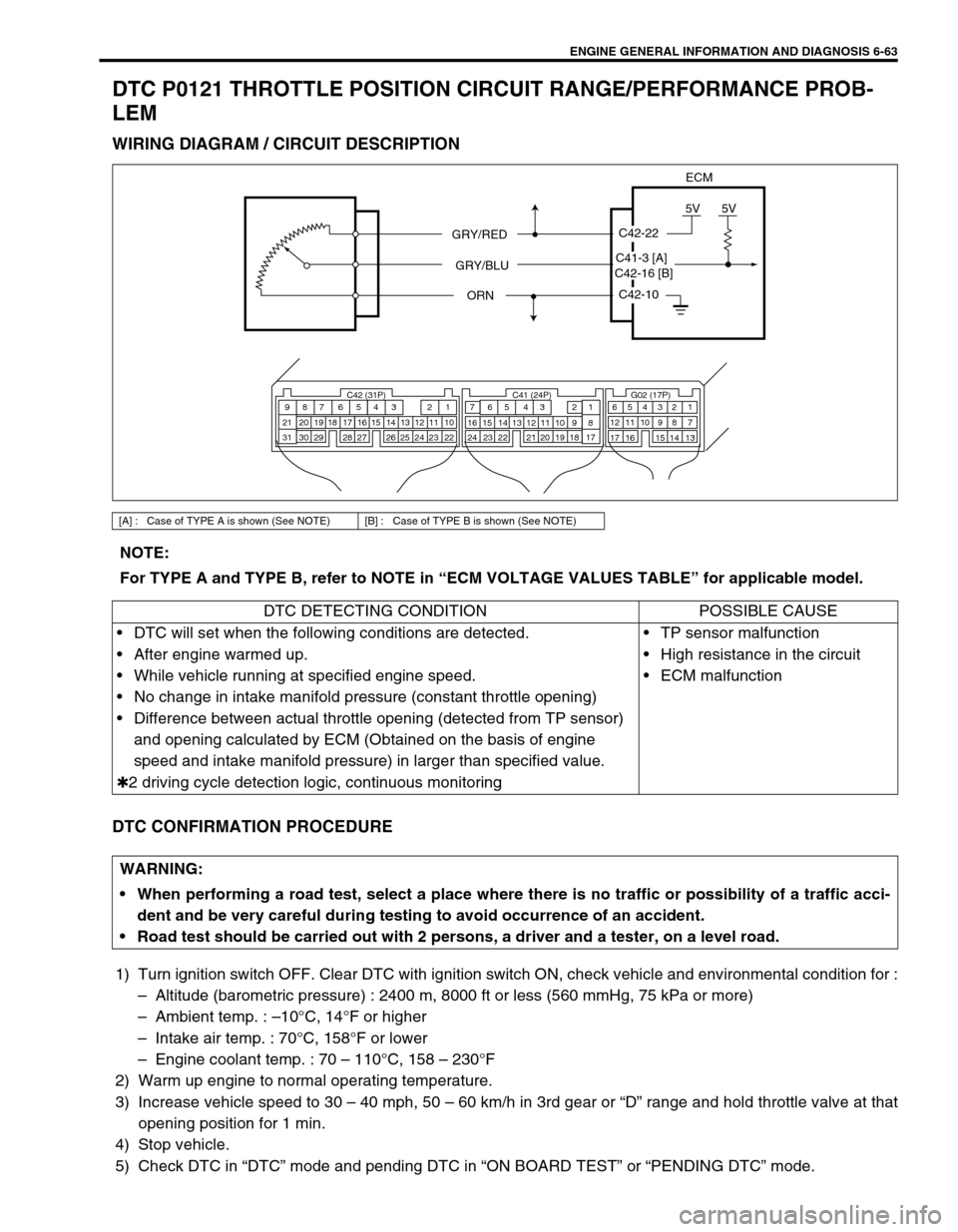
ENGINE GENERAL INFORMATION AND DIAGNOSIS 6-63
DTC P0121 THROTTLE POSITION CIRCUIT RANGE/PERFORMANCE PROB-
LEM
WIRING DIAGRAM / CIRCUIT DESCRIPTION
DTC CONFIRMATION PROCEDURE
1) Turn ignition switch OFF. Clear DTC with ignition switch ON, check vehicle and environmental condition for :
–Altitude (barometric pressure) : 2400 m, 8000 ft or less (560 mmHg, 75 kPa or more)
–Ambient temp. : –10°C, 14°F or higher
–Intake air temp. : 70°C, 158°F or lower
–Engine coolant temp. : 70 – 110°C, 158 – 230°F
2) Warm up engine to normal operating temperature.
3) Increase vehicle speed to 30 – 40 mph, 50 – 60 km/h in 3rd gear or “D” range and hold throttle valve at that
opening position for 1 min.
4) Stop vehicle.
5) Check DTC in “DTC” mode and pending DTC in “ON BOARD TEST” or “PENDING DTC” mode.
[A] : Case of TYPE A is shown (See NOTE) [B] : Case of TYPE B is shown (See NOTE)
C42-10
C42-22
5V5V
ECM
GRY/RED
GRY/BLU
ORN
C42 (31P) C41 (24P) G02 (17P)1 2 3 4 5 6 7 8 9
10 11 12 13 14 15 16 17 18 19 20 21
22 23 24 25 26 28 27 29 30 315 6
1 2 3 4 5 6 7
11 12
9 10 11 13 12 14 15 16
16 171 2
7 8
13 14 3 4
9 10
15 17 188
19 20 21 22 23 24
C42-16 [B]C41-3 [A]
NOTE:
For TYPE A and TYPE B, refer to NOTE in “ECM VOLTAGE VALUES TABLE” for applicable model.
DTC DETECTING CONDITION POSSIBLE CAUSE
DTC will set when the following conditions are detected.
After engine warmed up.
While vehicle running at specified engine speed.
No change in intake manifold pressure (constant throttle opening)
Difference between actual throttle opening (detected from TP sensor)
and opening calculated by ECM (Obtained on the basis of engine
speed and intake manifold pressure) in larger than specified value.
✱2 driving cycle detection logic, continuous monitoringTP sensor malfunction
High resistance in the circuit
ECM malfunction
WARNING:
When performing a road test, select a place where there is no traffic or possibility of a traffic acci-
dent and be very careful during testing to avoid occurrence of an accident.
Road test should be carried out with 2 persons, a driver and a tester, on a level road.
Page 435 of 698
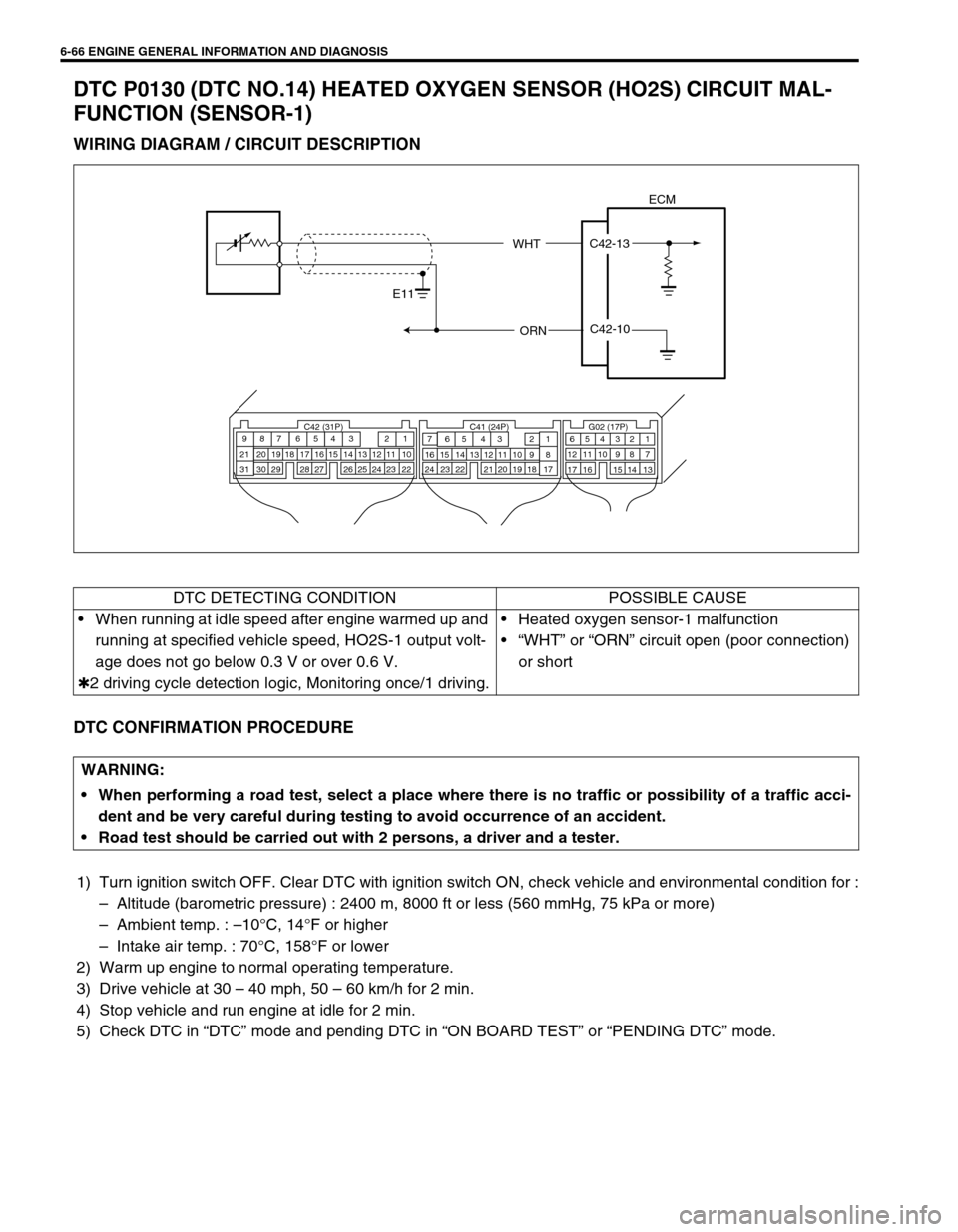
6-66 ENGINE GENERAL INFORMATION AND DIAGNOSIS
DTC P0130 (DTC NO.14) HEATED OXYGEN SENSOR (HO2S) CIRCUIT MAL-
FUNCTION (SENSOR-1)
WIRING DIAGRAM / CIRCUIT DESCRIPTION
DTC CONFIRMATION PROCEDURE
1) Turn ignition switch OFF. Clear DTC with ignition switch ON, check vehicle and environmental condition for :
–Altitude (barometric pressure) : 2400 m, 8000 ft or less (560 mmHg, 75 kPa or more)
–Ambient temp. : –10°C, 14°F or higher
–Intake air temp. : 70°C, 158°F or lower
2) Warm up engine to normal operating temperature.
3) Drive vehicle at 30 – 40 mph, 50 – 60 km/h for 2 min.
4) Stop vehicle and run engine at idle for 2 min.
5) Check DTC in “DTC” mode and pending DTC in “ON BOARD TEST” or “PENDING DTC” mode.
ECM
WHT
ORNC42-10 C42-13
E11
C42 (31P) C41 (24P) G02 (17P)1 2 3 4 5 6 7 8 9
10 11 12 13 14 15 16 17 18 19 20 21
22 23 24 25 26 28 27 29 30 315 6
1 2 3 4 5 6 7
11 12
9 10 11 13 12 14 15 16
16 171 2
7 8
13 14 3 4
9 10
15 17 188
19 20 21 22 23 24
DTC DETECTING CONDITION POSSIBLE CAUSE
When running at idle speed after engine warmed up and
running at specified vehicle speed, HO2S-1 output volt-
age does not go below 0.3 V or over 0.6 V.
✱2 driving cycle detection logic, Monitoring once/1 driving.Heated oxygen sensor-1 malfunction
“WHT” or “ORN” circuit open (poor connection)
or short
WARNING:
When performing a road test, select a place where there is no traffic or possibility of a traffic acci-
dent and be very careful during testing to avoid occurrence of an accident.
Road test should be carried out with 2 persons, a driver and a tester.
Page 437 of 698
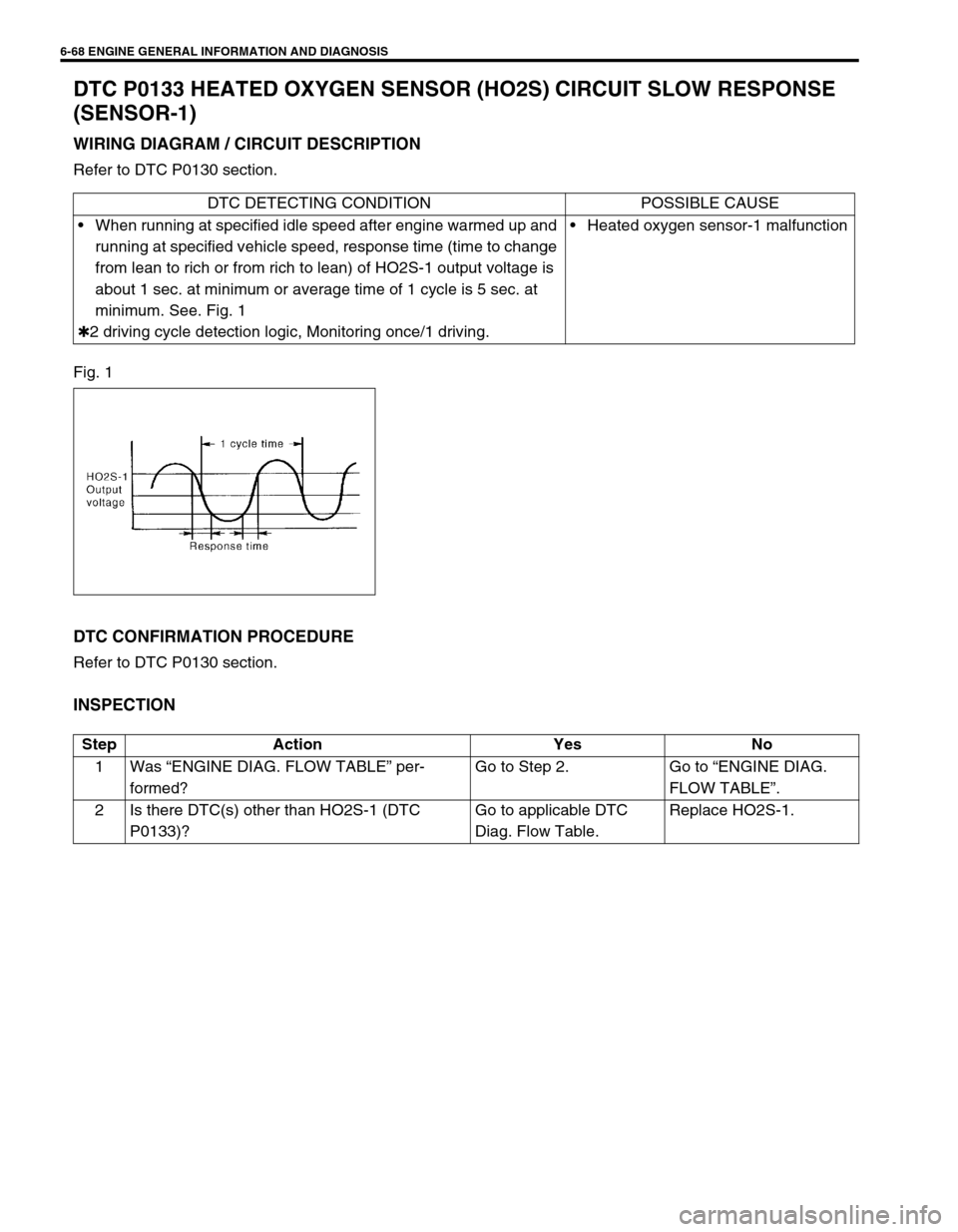
6-68 ENGINE GENERAL INFORMATION AND DIAGNOSIS
DTC P0133 HEATED OXYGEN SENSOR (HO2S) CIRCUIT SLOW RESPONSE
(SENSOR-1)
WIRING DIAGRAM / CIRCUIT DESCRIPTION
Refer to DTC P0130 section.
Fig. 1
DTC CONFIRMATION PROCEDURE
Refer to DTC P0130 section.
INSPECTION
DTC DETECTING CONDITION POSSIBLE CAUSE
When running at specified idle speed after engine warmed up and
running at specified vehicle speed, response time (time to change
from lean to rich or from rich to lean) of HO2S-1 output voltage is
about 1 sec. at minimum or average time of 1 cycle is 5 sec. at
minimum. See. Fig. 1
✱2 driving cycle detection logic, Monitoring once/1 driving.Heated oxygen sensor-1 malfunction
Step Action Yes No
1Was “ENGINE DIAG. FLOW TABLE” per-
formed?Go to Step 2. Go to “ENGINE DIAG.
FLOW TABLE”.
2 Is there DTC(s) other than HO2S-1 (DTC
P0133)?Go to applicable DTC
Diag. Flow Table.Replace HO2S-1.